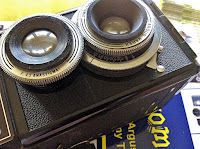The Argoflex E has a 75mm f/4.5 Varex Anastigmat lens (uncoated in pre-war version). The shutter speeds are 1/10 – 1/200, sec, plus B and T. Apertures range from f/4.5-f/18. There is a place to screw in a remote release on the rim of the shutter housing. The viewing lens features a depth of field scale that you can view from above.
The post-war Argoflex E (1946-1948) can also use 120 film, contrary to Henry Gambino's assertion in Argomania. Of course, with Argus always tweaking things, it's possible that some cameras made later in the cycle do not accept 120 in the supply side of the camera. The post-war Argoflex E also has a coated lens, which should help with flare.
The Argoflex E does not have double-exposure prevention, so it can be used to make multiple exposures. For some, that may make it a very ideal TLR.
What about other Argoflex models?
After Argus shelved the Argoflex II and replaced it with the Argoflex EM (1948) and EF (1948-1951), these metal-bodied cameras took only 620 film, and 120 film spools cannot be used in them.
 The later Argoflexes do not have coupled taking and viewing lenses, and except for the Argus Super 75 and the Argus 40, do not have adjustments except for “Instant” and “Time.” None of these models can use 120 film rolls.
The later Argoflexes do not have coupled taking and viewing lenses, and except for the Argus Super 75 and the Argus 40, do not have adjustments except for “Instant” and “Time.” None of these models can use 120 film rolls. So, the Argoflex E is certainly still a usable camera, and since it readily accepts 120 film, it's worth a try. Some things to look for and to be aware of, though. Number one is the reflex mirror, which is now over 70 years old, and may be de-silvering or corroded, or just very dusty, depending on where the camera was kept all this time. In other words, the image in the viewfinder will not be as bright as that of a Rollei or a Yashicamat. The shutters appear to be fairly dependable, but remember that these are old cameras, so they could be sluggish. The lenses may also need cleaning if they are hazy. In addition, the lack of coated lenses will probably give you less-contrast in the image. One remedy would be to find a UV filter that can slip in place over the taking lens (there is no threaded filter ring). The Argoflex E is certainly as better camera than the Kodak reflex cameras, all of which require 620 film.
Should you buy one? I would say it depends on the condition of the camera and of course, the price. While not as complex or as well engineered as cameras from the 50s - 70s, it can produce sharp images when stopped down. Depending on the lens condition, wide-open quality will vary. The reflex mirror's age will also produce a dimmer image in the viewfinder, but using the pop-up magnifier may help with focus. I would not pay more than $40 for one.
On February 6, the A3C3 met up at Matthaei Botanical gardens. I shot a roll of Ilford Delta 100 in the Argoflex E, and developed it in D76, 1:1. Overall, my light-meter estimation worked pretty well, and the images came out better than expected. Here are a few.






3 comments:
Awesome. I've developed a hankering for simple 120 cameras -- surprisingly hard to find thanks to the 620 boondoggle -- and will add this one to my list of to-buy cameras!
Argus was awfully good at hitting that "not a great camera, but a very good camera for the price" part of the market in those days.
At one point, I was trying to sort out which E's would only take 620, but never really got enough examples for a definitive answer.
Just picked one up for $27, and it has a history I was able to discover which makes it worth so much more to me. Love the middle pic with the iPhone :-)
Thanks again for the info. Mine is a pre war version.
Post a Comment